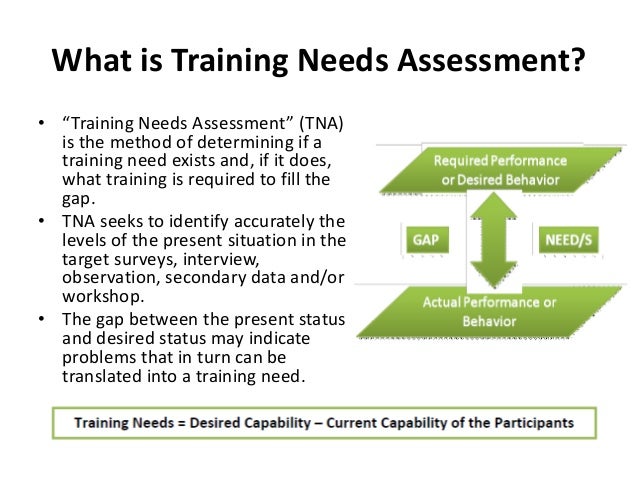
Image source: https://image.slidesharecdn.com/trainingneedassessment-140410234023-phpapp01/95/training-need-assessment-4-638.jpg?cb=1397173675
If you are considering developing and delivering a training program for your organization, here's the first step!
The needs analysis is a crucial activity in the training and development process. All training programs must begin with a needs analysis, therefore the needs analysis is usually the first step in the training process.
The purpose of the needs analysis is to identify what performance requirements are needed in order to fulfill the organization's goals and objectives and to improve productivity, profits, and quality of service.
There are two major reasons for conducting a needs analysis. First, it will identify specific steps that must be taken in order to make improvements. Second, it will provide the information to justify any expense you may incur as a result of training.
The objective in conducting a needs analysis is to find answers to the following questions:
- "Why" is training needed?
- "What" form of training is needed?
- "When" is the training needed?
- "Where" is the training needed?
- "Who" needs the training?
- "How" will the training be performed?
By determining training needs, an organization can decide what specific knowledge, skills, and attitudes are needed to improve the employee's performance in accordance with the company's standards. The following four methods for collecting data include surveys, observations, interviews, and customer comment cards.
1. SURVEYS
Surveys are used to focus on specific areas of performance deficiency. Surveys can be administered either by management or an outside professional. The surveys consist of a written questionnaire that employees answer on an anonymous basis which will allow them to answer freely and be truthful with their answers. The questions on the survey should be highly oriented toward the specific tasks, responsibilities and needs of the organization and its employees.
2. OBSERVATIONS
Observations involve just that--watching! Observing the employees at work can provide the trainer with sufficient information as to where the deficiencies exist. The only problem with this method is that the employees will tend to perform appropriately as a result of being watched (that is, if they know they are being watched).
3. INTERVIEWS
Interviews involve talking with each individual employee or as a group to discuss what possible problems and issues are responsible for the deficiencies. This method is a very decentralized and democratic approach to training in that it allows for the suggestions and opinions of the employees.
4. CUSTOMER COMMENT CARDS
Customer comment cards serve as a major source of information as to what the deficiencies may be. They often indicate what specific areas need improvement and why. Be sure that each question on the customer comment card is directed toward a specific service already offered in order to determine its effectiveness.
In collecting data through a needs analysis, the need for training will be apparent if you discover customer dissatisfaction, low morale, low productivity and high turnover among employees.
Customer dissatisfaction is a strong indication of a need for training. Remember, how the complaint is handled may determine whether the customer returns or not.
Low morale indicates unhappy employees (which eventually translates into unproductive employees). Inadequate training may be a cause of low morale as it makes the employees feel unprofessional, inadequate, and unimportant.
Low productivity is an indication of ineffective training, or even the absence of training. As a manager, it is important to provide effective and efficient training that will allow the employee's output to surpass their input.
High turnover among employees is an indication of unhappy and ineffectively trained employees. The employees may be suffering from stress as a result of these factors, and this will cause them to want to leave their jobs.
The needs analysis is the starting point for all training. The primary objective of all training is to improve individual and organizational performance. Conducting a needs analysis is the first step in the positive direction. In the training process it will tell you why, what, when, where, who, and how training should be implemented in your organization. With this information, the trainer can begin to develop productive and successful training programs.